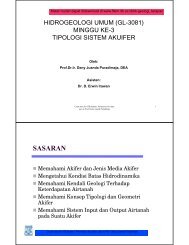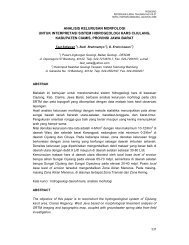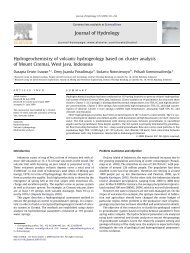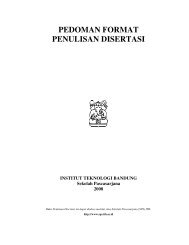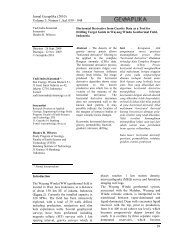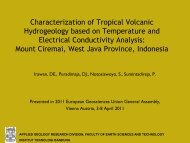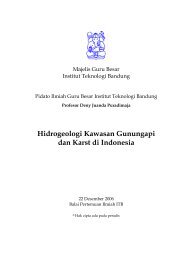Jurnal Geoaplika (2010) Volume 5, Nomor 1, hal. 049 â 059 49 - ITB
Jurnal Geoaplika (2010) Volume 5, Nomor 1, hal. 049 â 059 49 - ITB
Jurnal Geoaplika (2010) Volume 5, Nomor 1, hal. 049 â 059 49 - ITB
You also want an ePaper? Increase the reach of your titles
YUMPU automatically turns print PDFs into web optimized ePapers that Google loves.
Total dissolved solid (TDS), electric<br />
conductivity (EC) and chemical composition of<br />
thermal water are given in Table 1. Figure 3<br />
shows that the CSL-01 thermal water is HCO 3<br />
type, whereas the CSL-07 water is Cl type.<br />
Compared to the CSL-01 water, the CSL-07<br />
thermal water has pH of weak basic, lower<br />
TDS and EC, and lower concentrations of<br />
alkalis and ferromagnesian. However, both<br />
CSL-01 and 07 waters have major cation of Na.<br />
In addition, because the CSL-07 thermal water<br />
contains more Cl than the CSL-01 water, the<br />
CSL-07 water has higher SiO 2 and more<br />
balance ratio of cation to anion. Table 1 and<br />
Figure 3 also show that the composition and<br />
type of the Cisolok thermal water given by<br />
Priadi and Herdianita (2005) slightly differ<br />
from this time. According to Priadi and<br />
Herdianita (2005), the Cisolok thermal water is<br />
SO 4 type having high SiO 2 concentration.<br />
Figure 3. Relative concentration of Cl - SO 4 -<br />
HCO 3 (in mg/L) of hot springs in the study<br />
area. Point 01 is sample CSL-01, 07 is sample<br />
CSL-07, and CRM is sample from<br />
Cisukarame. Point 2005 is taken from Priadi<br />
and Herdianita (2005) as comparison.<br />
Surface geothermal manifestation of<br />
Cisukarame is located about 6 km north of the<br />
Cisolok manifestation. A hot pool occurs in the<br />
middle of rice field in Cisukarame. The thermal<br />
water (CRM) has temperature of 46 o C and pH<br />
of about 7.7. Its flow rate is very low. The type<br />
and characteristic of warm water of<br />
Cisukarame are similar to CSL-01, i.e.<br />
dominated by major anion of HCO 3 and major<br />
cation of Na. No surface alteration is found<br />
around the hot pool, except a mixture of<br />
colloidal silica and organic material found in<br />
the water surface of hot pool.<br />
Surface Alteration<br />
Surface hydrothermal alteration in Cisolok is<br />
present along approximately 400 m. Around the<br />
northern most hot spring of CSL-01, there is<br />
white travertine deposit covered the<br />
surrounding rocks and alluvial materials<br />
(Figure 4). The deposit is friable and breakable<br />
it is a product of young and active geothermal<br />
system. Atabey (2002) and Sant’Anna et al.<br />
(2004) classified this kind of deposit as micritic<br />
travertine containing impurities of aragonite,<br />
arsenic, antimony, sulphur, pyrite, goethite,<br />
hematite, and smectite.<br />
Right to the west bank of CSL-01 until about 6<br />
m to the headwater of Cisolok river, there is<br />
fossil of travertine deposit. The deposit can be<br />
separated into several continuous layers. Each<br />
layer has different texture, i.e. crustiform,<br />
colloform, stromatholitic, comb, sucrose and<br />
dogteeth. Brecciation is always found at the<br />
lower part. According to the classification of<br />
Özkul et al. (2002), this travertine fossil is<br />
belong to the crystalline crust travertine and<br />
pebbly travertine lithofacies. Fossil of<br />
travertine is still dominant at CSL-02 and 03.<br />
Locally, the travertine associates with fossil of<br />
silica sinter. Here, the sinter is massive, not<br />
layering, but fractured. The deposit can be<br />
classified into the lithoclast travertine<br />
lithofacies.<br />
Propylitic alteration zone forms at CSL-04 and<br />
06. The alteration changes igneous rock of<br />
dacitic and is marked by the presence of<br />
disseminated pyrite and quartz and calcite<br />
veins. Mostly, the veins show textures of<br />
crustiform and colloform. Amorphous silica<br />
sinter seems to cover the propylitic altered<br />
rocks and it is found in the river bank.<br />
Location of CSL-05 is located at east bank of<br />
the Cisolok river where the pebbly travertine<br />
lithofacies associated with silica sinter is found.<br />
Textures of the surface deposit include comb,<br />
crustiform and colloform. Calcite is mostly<br />
microcrystalline, but some are bladed and<br />
sugary calcites. Simmons and Christenson<br />
(1994) revealed that textures of comb,<br />
crustiform, colloform and sugary calcites are<br />
commonly found in calcite deposit, but bladed<br />
calcite is only found at condition indicating sub<br />
surface boiling.<br />
53





